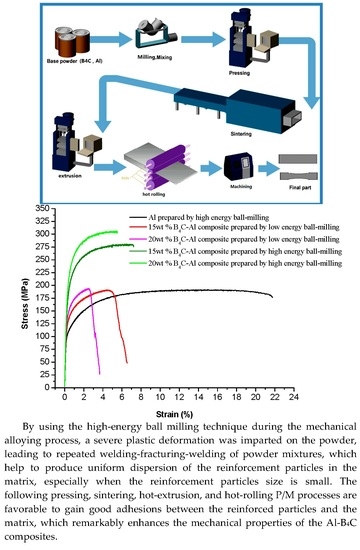B4C-Al Composites Fabricated by the Powder Metallurgy Process
Abstract
:Featured Application
Abstract
1. Introduction
2. Materials and Methods
3. Results and Discussion
3.1. Microstructure Analysis
3.2. Mechanical Properties
4. Conclusions
- The yield strength of the 15 wt % and 20 wt % B4C-Al composites prepared by the high-energy ball milling process is 184 MPa and 213 MPa, respectively, which are ~70% and ~97% higher than those of the pure Al samples prepared at the same condition. The tensile strength is 281 MPa and 306 MPa, respectively, which is ~47% and ~60% higher than the pure Al samples. On the contrary, the yield strength and tensile strength of the composites prepared by the low-energy ball milling process increases slightly with the B4C particles reinforcement.
- Microstructural, fracture surface analysis and neutron radiography indicated that composites prepared by high-energy ball milling have a homogeneous distribution of B4C particles in the Al matrix and tight adhesions between the reinforced particles and the matrix, which give rise to better load transfer from the matrix to the reinforcement and dramatically enhance the yield and tensile strength of Al-B4C composites.
- High-energy ball milling is an effective process to prevent the clustering of the reinforcement particles in the matrix even if the matrix-to-reinforcement particle size ratio was nearly 10. The following pressing, sintering, hot-extrusion, and hot-rolling P/M processes are favorable to gain good adhesions between the reinforced particles and the matrix, which remarkably enhances the mechanical properties of the Al-B4C composites.
Acknowledgments
Author Contributions
Conflicts of Interest
References
- Oñoro, J.; Salvador, M.D. High-temperature mechanical properties of aluminium alloys reinforced with boron carbide particles. Mater. Sci. Eng. A 2009, 499, 421–426. [Google Scholar] [CrossRef]
- Toptan, F.; Kilicarslan, A. Processing and microstructural characterization of AA 1070 and AA 6063 matrix B4Cp reinforced composites. J. Mater. Des. 2010, 31, S87–S91. [Google Scholar] [CrossRef]
- Sivasankaran, S.; Sivaprasad, K. Synthesis, structure and sinterability of 6061 AA100-x-x wt.% TiO2 composites prepared by high-energy ball milling. J. Alloys Compd. 2010, 491, 712–721. [Google Scholar] [CrossRef]
- Kerti, I.; Toptan, F. Microstructural variations in cast B4C-reinforced aluminium matrix composites (AMCs). Mater. Lett. 2008, 62, 1215–1218. [Google Scholar] [CrossRef]
- Shorowordi, K.M.; Laoui, T. Microstructure and interface characteristics of B4C, SiC and Al2O3 reinforced Al matrix composites: A comparative study. J. Mater. Process. Technol. 2003, 142, 738–743. [Google Scholar] [CrossRef]
- Yücel, O.; Tekin, A. The fabrication of boron carbide-aluminium composites by explosive consolidation. Ceram. Int. 1997, 23, 149–152. [Google Scholar] [CrossRef]
- Mohanty, R.M.; Balasubramanian, K. Boron carbide-reinforced aluminum 1100 matrix composites: Fabrication and properties. Mater. Sci. Eng. A 2008, 498, 42–52. [Google Scholar] [CrossRef]
- Jiang, Q.C.; Wang, H.Y. Fabrication of B4C particulate reinforced magnesium matrix composite by powder metallurgy. J. Alloys Compounds 2005, 386, 177–181. [Google Scholar] [CrossRef]
- Ünal, R.; Sarpün, Ì.H. The mean grain size determination of boron carbide (B4C)-aluminium(Al) and boron carbide(B4C)-nickel(Ni) composites by ultrasonic velocity technique. Mater. Charact. 2006, 56, 214–244. [Google Scholar] [CrossRef]
- Mashhadi, M.; Taheri-Nassaj, E. Effect of Al addition on pressureless sintering of B4C. Ceram. Int. 2009, 35, 831–837. [Google Scholar] [CrossRef]
- Viala, J.C.; Bouix, J. Chemical reactivity of aluminimu with boron carbide. J. Mater. Sci. 1997, 32, 4559–4573. [Google Scholar] [CrossRef]
- Arslan, G.; Kara, F. Quantitative X-ray diffraction analysis of reactive infiltrated boron carbide-aluminium composites. J. Eur. Ceram. Soc. 2003, 23, 1243–1255. [Google Scholar] [CrossRef]
- Ma, Q.-C.; Zhang, G.-J. Effect of additives introduced by ball milling on sintering behavior and mechanical properties of hot-pressed B4C ceramics. Ceram. Int. 2010, 36, 167–171. [Google Scholar] [CrossRef]
- Abenojar, J.; Velasco, F. Optimization of processing parameters for the Al + 10% B4C system obtained by mechanical alloying. J. Mater. Process. Technol. 2007, 184, 441–446. [Google Scholar] [CrossRef]
- Shi, J.M.; Shen, C.-L. Corrosion Mechanism of Al-B4C Composite Materials in Boric Acid. Atomic Energy Sci. Technol. 2012, 46, 972–977. [Google Scholar]
- Hilger, A.; Kardjilov, N. Revealing microstructural inhomogeneities with dark-field neutron imaging. J. Appl. Phys. 2010, 107, 036101. [Google Scholar] [CrossRef]
- Scott, P.B.; Johnson, S.E. Neutron radiographs using the ionographic process. J. Appl. Phys. 1978, 49, 5078–5080. [Google Scholar] [CrossRef]
- Zhang, L.; Shen, C.L. The Preparation of B4C-Al Composites. China Patent ZL201010607497.5, 11 July 2012. [Google Scholar]
- Shi, J.M.; Lei, J.R. Corrosion Behaviors of Al-B4C Composite Materials. Atomic Energy Sci. Technol. 2010, 44, 159–165. [Google Scholar]
- Shen, C.L.; Shi, J.M. Effect of ball milling technics on B4C-Al composite performance. Funct. Mater. 2011, 42, 365–369. [Google Scholar]
- Shi, J.M.; Zhang, L. Corrosion behavior of Al-B4C composite in spent nuclear fuel storage environment. J. Chin. Soc. Corros. Prot. 2013, 33, 419–424. [Google Scholar]
- Zhang, L.; Shi, J.M. Neutron absorption properties of Al-B4C composites materials. Mater. Rev. 2016, 30, 21–25. [Google Scholar]
- Griger, A.; Stefaniay, V. Crystallographic data and chemical compositions of aluminium-rich aluminum-iron intermetallic phases. Z. Metallkd. 1986, 77, 30. [Google Scholar]
- Kouzeli, M.; Marchi, C.S. Effect of reaction on the tensile behavior of infiltrated boron carbide-aluminum composites. Mater. Sci. Eng. A 2002, 337, 264–273. [Google Scholar] [CrossRef]
- Dutt, B.S.; Babu, M.N. Influence of microstructural inhomogeneities onf the fracture toughness of modified 9Cr-1Mo steel ant 298–823K. J. Nucl. Mater. 2012, 421, 15–21. [Google Scholar] [CrossRef]
- Torralba, J.M.; da Costa, C.E. P/M aluminum matrix composites: An overview. J. Mater. Process. Technol. 2003, 133, 203–206. [Google Scholar] [CrossRef]
- Slipenyuk, A.; Kuprin, V. The effect of matrix to reinforcement particle size ratio (PSR) on the microstructure and mechanical properties of a P/M processed AlCuMn/SiCp MMC. Mater. Sci. Eng. A 2004, 381, 165–170. [Google Scholar] [CrossRef]
- Slipenyuk, A.; Kuprin, V. Properties of P/M processed particle reinforced metal matrix composites specified by reinforcement concentration and matrix-to-reinforcement particle size ratio. Acta Mater. 2006, 54, 157–166. [Google Scholar] [CrossRef]
- Bhanu Prasad, V.V.; Bhat, B.V.R. Structure-property correlation in discontinuously reinforced aluminium matrix composites as a function of relative particle size ratio. Mater. Sci. Eng. A 2002, 337, 179–186. [Google Scholar] [CrossRef]
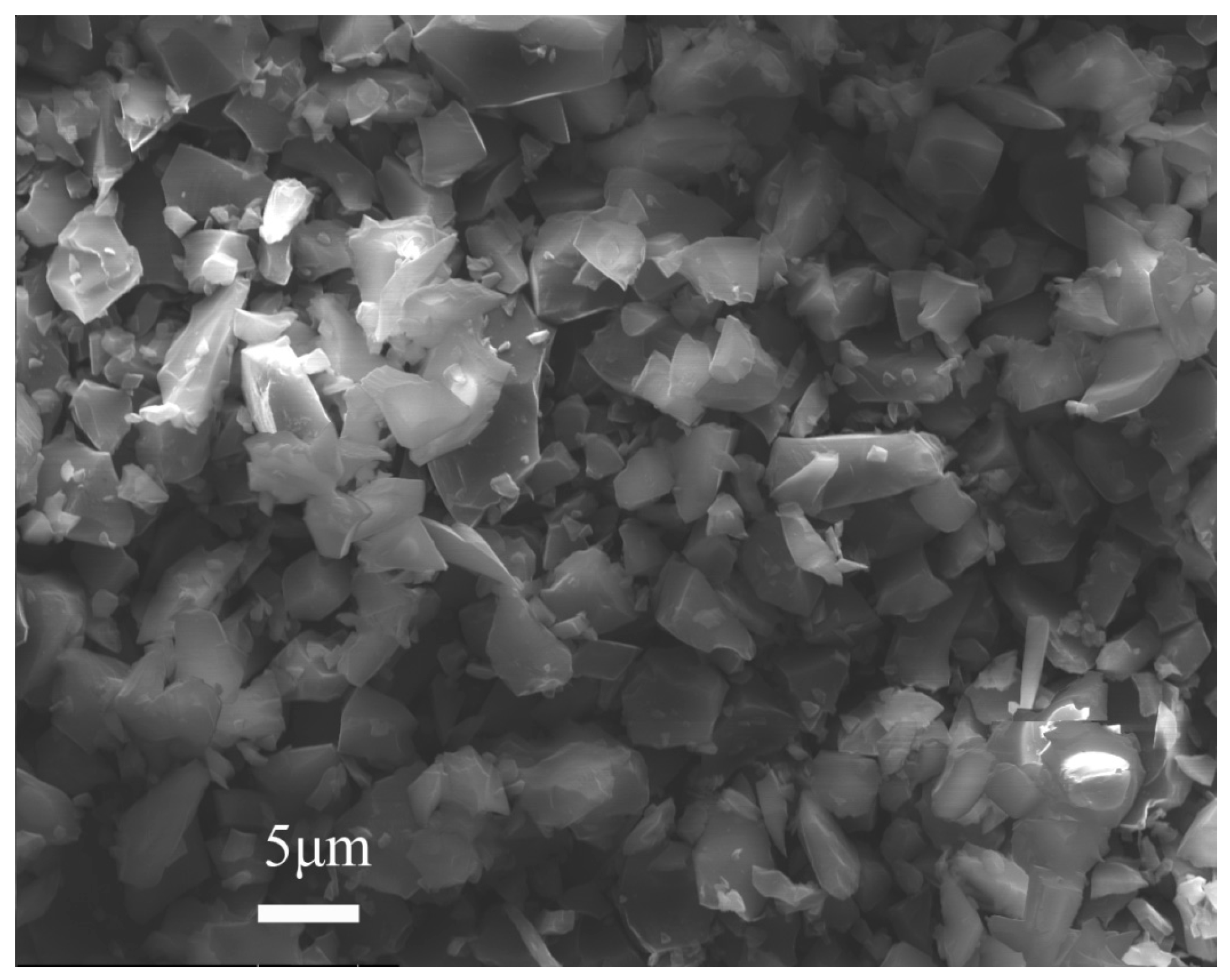
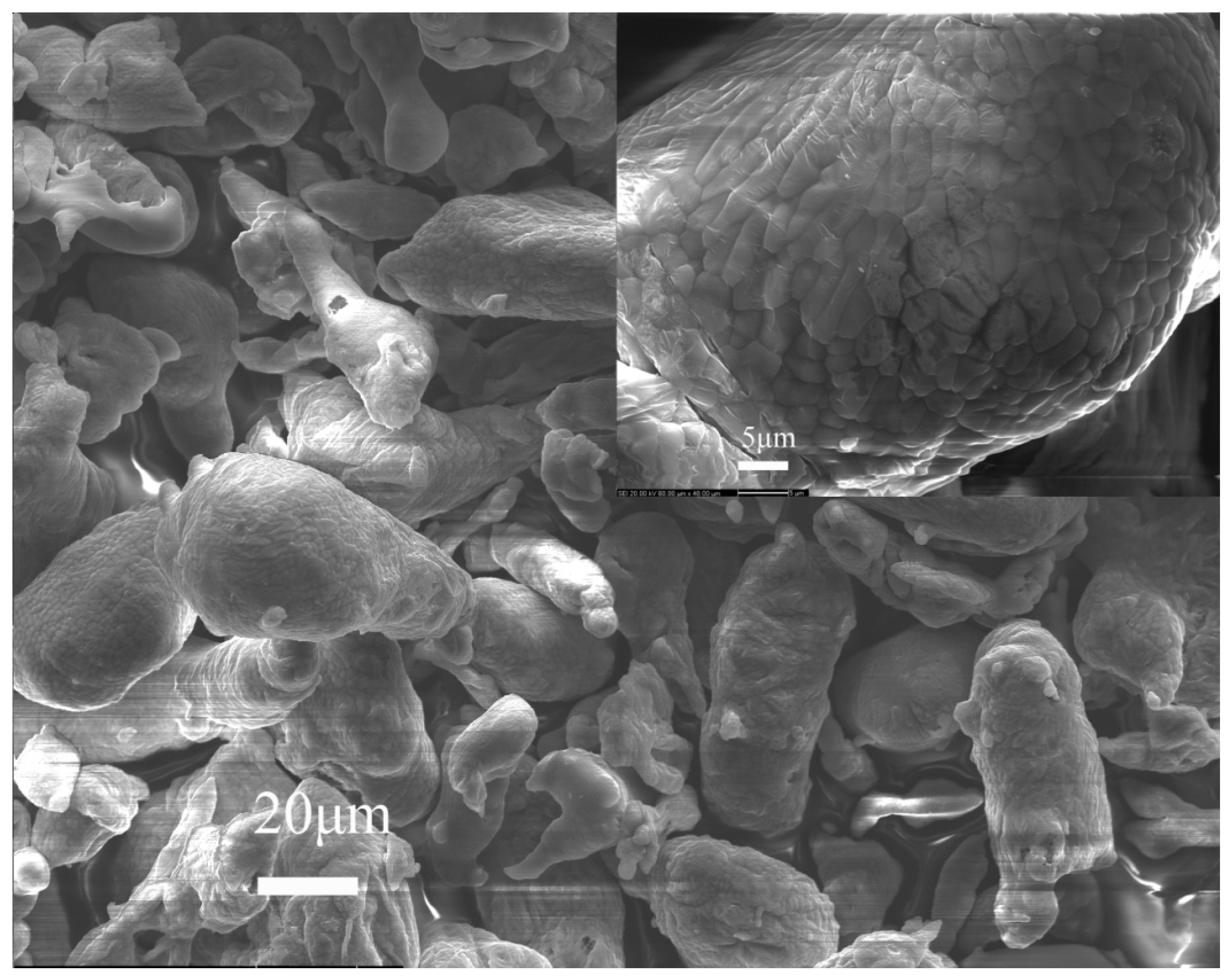

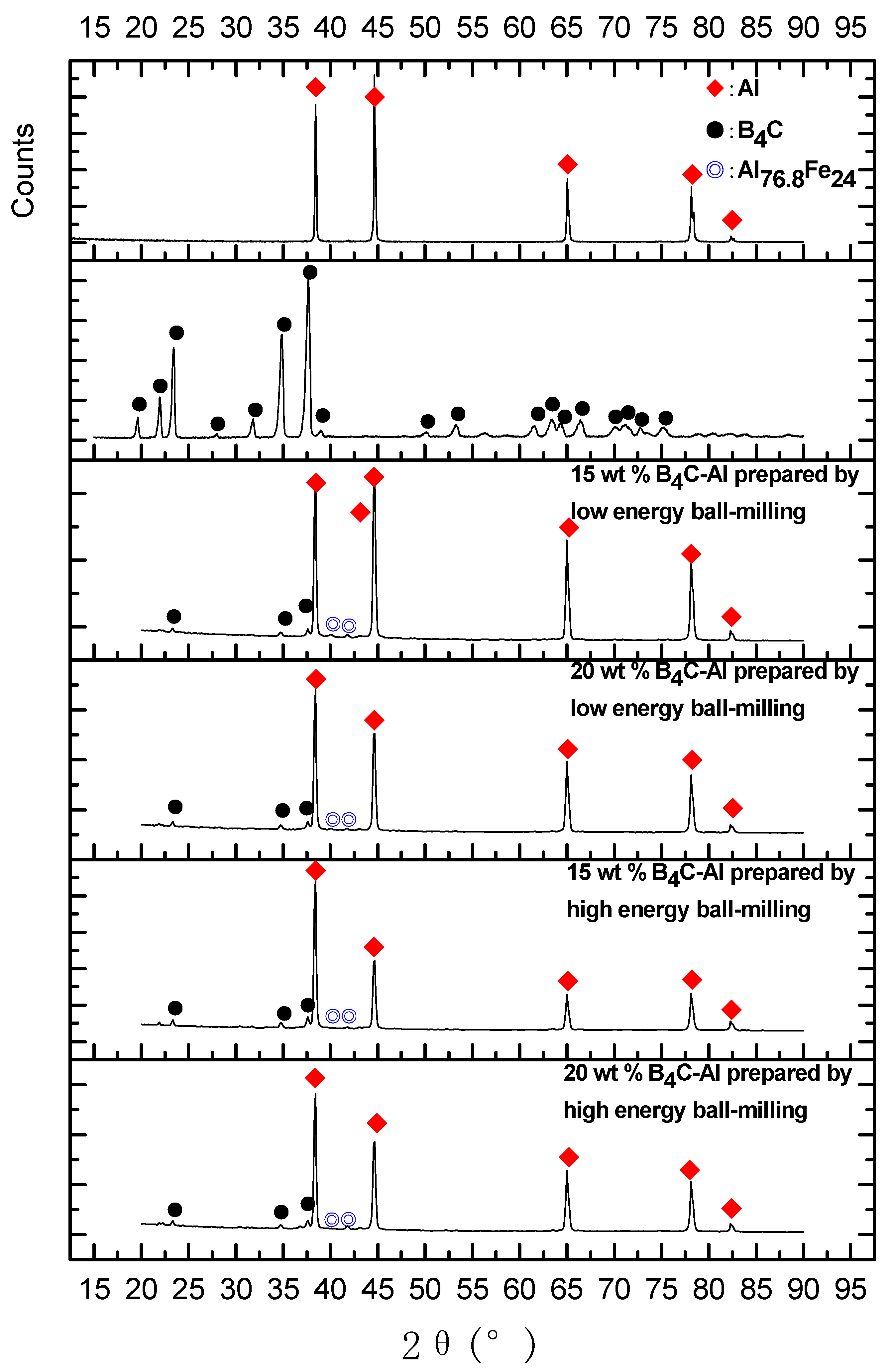
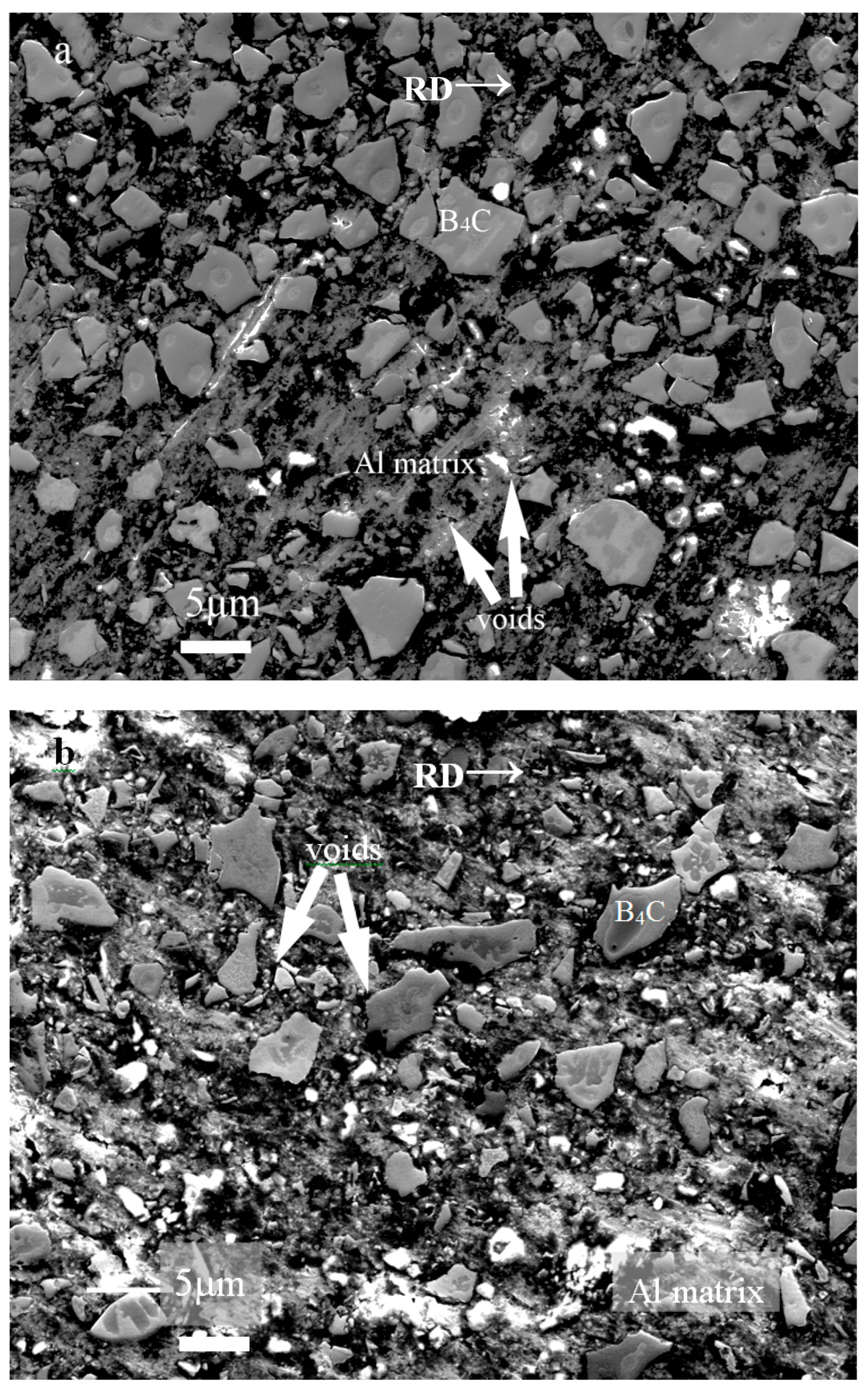

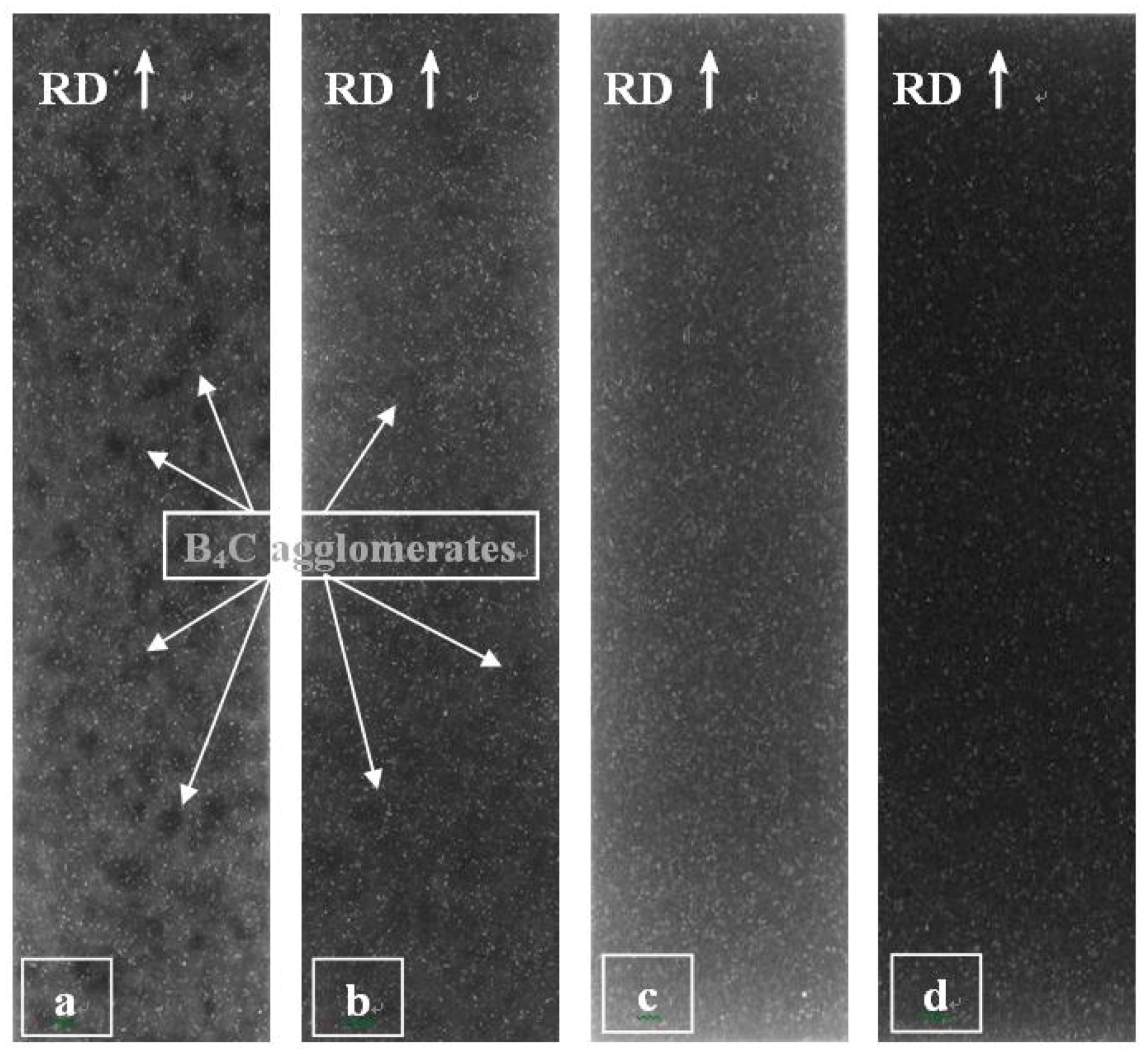

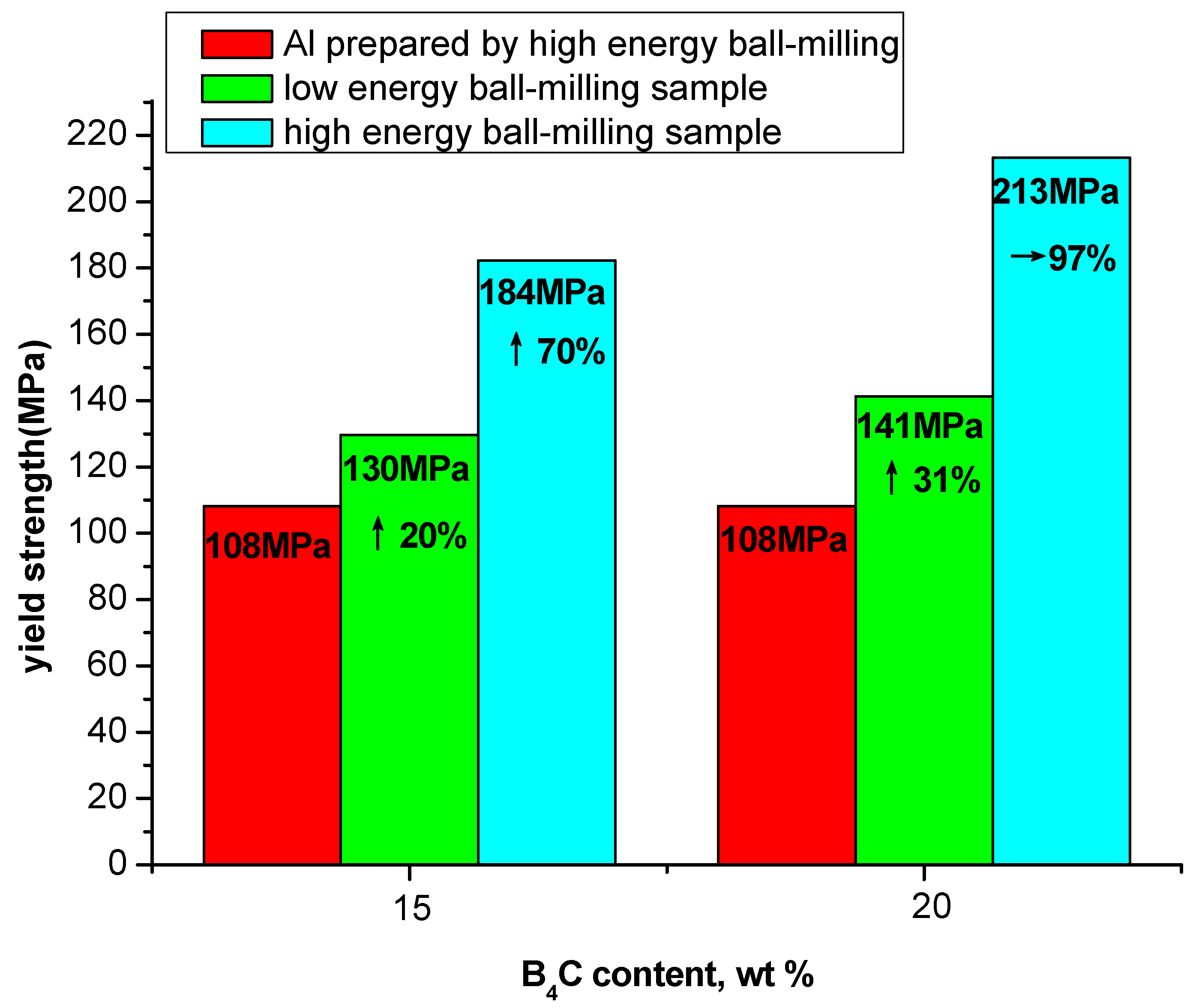

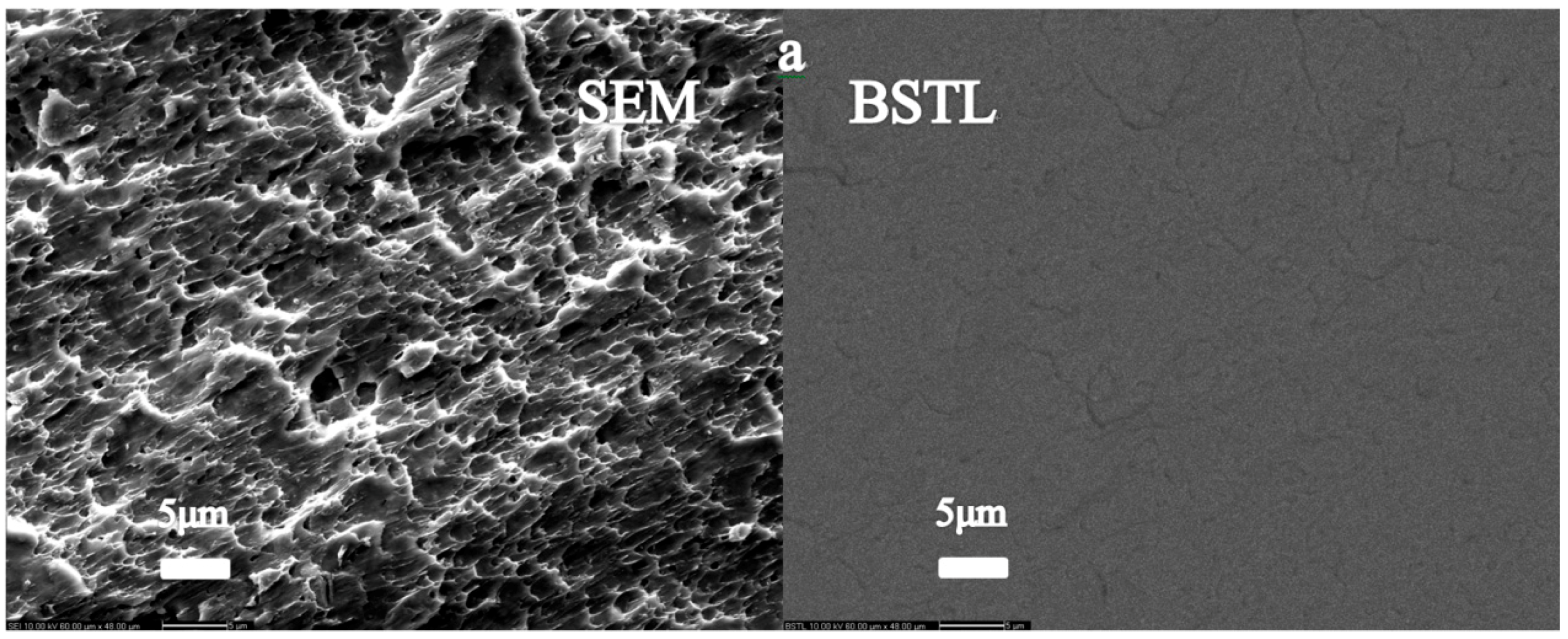

© 2017 by the authors. Licensee MDPI, Basel, Switzerland. This article is an open access article distributed under the terms and conditions of the Creative Commons Attribution (CC BY) license (http://creativecommons.org/licenses/by/4.0/).
Share and Cite
Zhang, L.; Shi, J.; Shen, C.; Zhou, X.; Peng, S.; Long, X. B4C-Al Composites Fabricated by the Powder Metallurgy Process. Appl. Sci. 2017, 7, 1009. https://doi.org/10.3390/app7101009
Zhang L, Shi J, Shen C, Zhou X, Peng S, Long X. B4C-Al Composites Fabricated by the Powder Metallurgy Process. Applied Sciences. 2017; 7(10):1009. https://doi.org/10.3390/app7101009
Chicago/Turabian StyleZhang, Ling, Jianmin Shi, Chunlei Shen, Xiaosong Zhou, Shuming Peng, and Xinggui Long. 2017. "B4C-Al Composites Fabricated by the Powder Metallurgy Process" Applied Sciences 7, no. 10: 1009. https://doi.org/10.3390/app7101009




